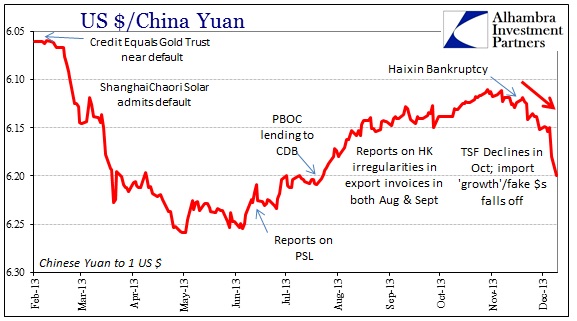It is really amazing how condensed events have become once the economic and financial world shifted off its axis in August 2007. What used to be conventional wisdom about monetary affairs before then has long since been forgotten to the point that “emergency” measures that appeared in the months thereafter now pass for “normal.” However, the idea of “normal” in this new normal isn’t working very well, and alternatives have already been introduced.
In the pre-crisis era, currency elasticity was quite well-known and seemingly defined. It was also totally ill-suited to anything of the modern shadow system, most especially the global eurodollar standard that dominated in the 1980’s forward. That is why central banks were so ill-prepared for 2008 as they were using 19th century tools for a 21st century operational framework. Belatedly catching up, but only after severe damage was done, shifted “currency elasticity” to “unconventional” standards such as QE. In one sense, it was the same idea, a flood of “liquidity”, but carried out through far different methods.
The result, as it has been judged by central banks themselves, was not much by way of economic expansion though overwhelmed by financial imbalance and redistribution; i.e., bubbles. So what was “unconventional” wisdom in the immediate aftermath of the Great Recession is now, only a few years later, passé. Liquidity is still important, but “broad” liquidity has yielded to experimentation with “targeted” liquidity.
China is at the forefront of this process, but it seems to be hard for most people to accept such a drastic shift in theory and practice. Some of that is surely due to the high praise for the upside of asset bubbles, and thus the rationalizations that no “sane” central banker would ever let it end. That is true in some sense, but central banks have been forced (again, by their own failures) to entertain the ideas about “how” bubbles might end.
And so the PBOC has economists totally uprooted from where they were comfortable and unable to grasp the essential elements of this new paradigm.
Costs for riskier issuers of notes rose as regulators banned the use of riskier debt as collateral for financing. Investors dialed back expectations for further monetary easing as policy makers seek to cool the stock rally.
“Financing costs moved in the opposite way than the central bank wished,” said Deng Haiqing, Beijing-based chief fixed-income analyst at Citic Securities Co., China’s biggest brokerage. “We don’t think the call for aggressive interest rate or reserve-requirement ratio cuts are well-grounded under current circumstances, as it could fuel bubbles in stocks.”
Financing costs did not move “in the opposite way” from where PBOC policy was set, that conjecture on the part of the credentialed economist only fits in the past course of “emergency” liquidity.
Since the People’s Bank of Chinasurprised markets with the first benchmark rate reduction in two years on Nov. 21, the five-year sovereign bond yield climbed 15 basis points, that for similar AAA corporate notes surged 37 and AA debt yields jumped 76. While finance companies did start charging less for mortgages, their funding costs rose as the one-week Shanghai interbank lending rate added 37 basis points.
That was the whole point of what happened in the past month or so. The PBOC acted to shore up only certain pieces of China’s financial system, those judged to be “good” and less likely to foster further bubbly imbalance; but these economists took the “first rate cut in 2 years” as the same old broad “stimulus” measure. But in the context of this kind of “reform” it makes perfect sense that the “rate cut” (which really wasn’t) would lead to higher funding rates for “other” parts of the Chinese system because they have been judged to be “bubbly.”
What if a central bank cut interest rates and borrowing costs rose?
That question only applies in the previous monetary context. In this stage of monetary “evolution” it is precisely the point.
In other words, the PBOC not only expects rising financing costs, it is actively seeking them out. What is unknown is how this will ultimately end, though the reaction of Chinese stocks, which clearly misinterpreted these signals (a common feature of stocks in this age of “emergency” elasticity), may only bring about more “targeted” tightening. The PBOC’s priorities have changed, and they have publicly proclaimed as much, as “growth” is no longer to be the highest priority; or, I should say, wasteful growth. Since most economists fail to see monetarism as anything but a tremendously successful endeavor this is hard for them to take as it strikes at the very core of their assumptions (what they think of somehow as settled science).
So far, PBOC Governor Zhou Xiaochuan’s has been true to his warning:
“If the central bank is not a part of the government, it is not efficient in coordinating policies to push forward reforms,” [Zhou] said.
“Our choice has its own rational reasons behind it. But this choice also has its costs. For example, whether we can efficiently cope with asset bubbles and inflation is questionable.”
After taking steps to address “discovered” deficiencies (PSL especially), Round 2 of that is underway and it is a big step beyond Round 1.


Stay In Touch